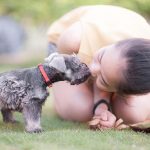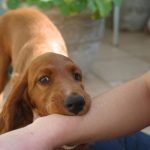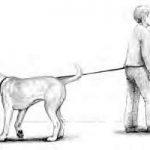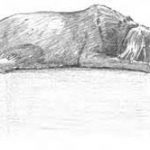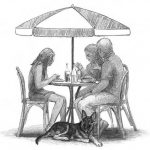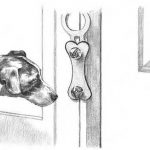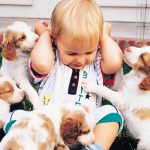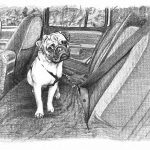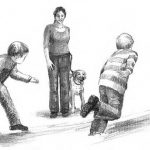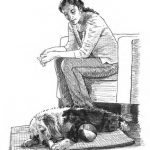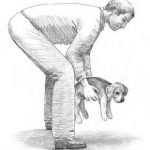Socialization and Civility
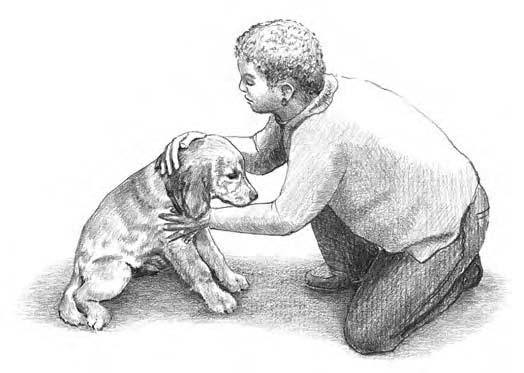
In This Chapter
- Calming your puppy during socialization
- Conditioning your puppy to accept people of all sizes, races, and genders
- Introducing your puppy to wild animals, noises, and other interesting objects
- Handling a pup’s wary or defensive response
Your puppy is hard-wired with a prime socialization window. During this window, which is between 8 to 12 weeks, her brain is developing and she’s receptive to new experiences. She’s constantly looking to you for your interpretation of these experiences. This is the time to introduce her to everything she will encounter throughout her life, from objects and people to noises and other animals.
Calming Your Puppy Based on Her Age
Acclimating a young pup (8 to 12 weeks)
Remember
When she’s very young, your puppy will mirror your reaction in all new situations. If you’re nervous, she will be too. If you get excited, uncomfortable, or edgy, she’ll follow suit. Expose your puppy to new experiences under controlled circumstances so you’ll be centered and prepared to deal with your puppy’s reaction.
– Fearfully: Noted by a hesitant body posture, these puppies pull back or scurry to leave the environment. Often they scratch to be held or acknowledged.
– Calmly: These pups are patiently observant and have a relaxed body posture and mild curiosity.
– Actively: Because they’re very interactive, these puppies explore the new stimulation with gusto and may be hard to calm down or refocus.
– Defensively: Puppies who act defensively may back up, hold still, or run forward. Or they may do all three maneuvers and bark or vocalize their feelings in some way. Their ears may be flattened against their heads, and they may hide behind your legs or try to climb up into your arms or lap.
Remember
Any attention given to a puppy reinforces her reaction, which is fine if and only if your puppy is reacting calmly. Other responses need redirecting. Read on to find out how.
Instilling confidence in a fearful pup
Finding the Red ZoneIf your puppy has an intense reaction (one that’s fearful, overexcited, or defensive) to a new situation or person, determine her Red Zone: the distance from the stimulus where she can stand comfortably. Stand just outside this zone and handle your puppy calmly using commands, toys, or treats to keep her focus. |
Warning!
Don’t coddle your puppy if she has a fearful reaction. Your immediate attention indicates submission, not leadership. Your lowered body posture and high-pitched tone convey the message that you’re afraid, too.
Capturing the attention of a calm pup
Containing the excitement of an active pup
Defusing a defensive pup
Warning!
An early defensive reaction (before 12 weeks) should be noted and taken seriously. If the tips in this book don’t lessen your puppy’s intensity, hire a professional. The onset of adolescence, with the release of adult hormones, will intensify an aggressive response. Deal with this behavior immediately.
Tip
Discover your puppy’s body language and take it very seriously. Focus on her eyes, body position, tail, and mouth. Even though she can’t talk in words, your puppy will tell you everything if you listen with your eyes. Check out Table 7-1 for guidance.
Table 7-1 | Reading Your Puppy’s Body Language | ||||
Body Part | Fearful | Undecided | Relaxed | Active | Defensive |
Eyes | Squinting, darting, | Focused or shifting | Focused | Attentive, focused | Glaring, hard |
Body | Low, arched, pulled back | Shifting from forward to pulled back, approaching but then immediately avoiding the person | Relaxed | Comfortable posture, moving side to side | Pitched forward, stone still, tense |
Tail | Tucked under belly, wagging low | Tucked under belly, arched slightly over back, fluctuating between the two | Still, gently swinging above rump | High, wagging enthsiastically | Still above rump or arched above back in a tight repetitive wag |
Mouth | Pulled back, often in a semi-smile | Terse, trembling | Normal | Painting, normal, may be parted in a growl or vocalization | Tight, unflinching, may be parted in a growl or vocaliazation |
Remember
If you look at your puppy or even glance back at her, your posture and visual confirmation may get misconstrued as insecurity. For example, think of playing on a team: The captain wouldn’t shout a direction and then look to the players for confirmation. The same rules apply with your pup. When directing your puppy, stand confident and focus on the situation at hand.
Teaching Your Puppy to Be Accepting of All People
Remember
Regardless of your puppy’s age, her ability to relate to others around her will be determined by three variables:
– Breed influences
– Socialization experience
– Your example
Socializing your young puppy (8 to 12 weeks)
Tip
A better plan is to actually have a plan. Expose and introduce your puppy to as many new people as time allows. You should follow the same routine whether the person is 9 or 90, dressed down, uniformed, or in costume.
Tip
Condition your puppy to a leash and collar, and keep these items on her when meeting new people. Use them to guide her, as if you’re holding a young child’s hand. When possible, ask people to ignore any extreme reactions, from hyperactivity to fear or defensiveness. Simply put, when she reacts extremely, act as if your puppy isn’t even there. When applied for a few minutes, this approach will de-escalate any concern and will condition your puppy to look to and reflect your reaction.
Tip
If your puppy is fearful or tense, ask the person to shake a treat cup and treat her so that she shapes a new and more positive outlook.
Shaping up older puppies
Warning!
When left unchecked, such behavior may result in a dog who’s permanently wary of children or defensive with the delivery man. Consider living with this erratic behavior for ten or more years — I guarantee it won’t be fun. However, this is one of the few times you have the power to reshape your future.
– Whoever is in front is in charge.
– A confident and calm body posture conveys confidence and self-assurance.
– A steady voice will be followed.
Remember
No matter what your puppy’s behavior is, it developed in large part because of your attention. Puppies repeat anything that ensures interaction — they don’t care whether it’s negative or positive interaction. If your pup is hyper, you likely tried to calm her by grabbing her fur, pushing her, or holding her. When a defensive or wary reaction results in a soothing and high-pitched “It’s okay,” the translation is that of mutual concern. What this puppy needs is a human example of confidence, which is conveyed with clear direction and a calm, upright body posture.
– Create a greeting station in sight of, but at least 6 feet behind, the greeting door (as detailed in Chapter Teaching Everyday Etiquette).
– Secure a short 2-foot leash to the area and repeat “Back” as you lead your puppy and attach her before opening the door.
– Ignore your puppy until she has fully calmed down.
Tip
If your puppy is defensive or fearful, put a head collar on her. This head collar automatically relaxes your puppy because the weight placed over her nose and behind her head stimulates the same pressure points her mother would use to calm her.
– Let’s go: Instructs your puppy to walk behind you and watch for your direction.
– Stay: Stresses impulse control and focus. Precede this direction with a “Sit” or “Down” direction.
– Under: Directs your puppy to lie under your legs or under a table. These safe places reinforce that you’re her guardian and protector.
– Wait: Instructs your puppy to stop in her tracks and look to you before proceeding.
– Back: Directs your puppy to get behind you and reminds her that you’re in charge.
Warning!
If your puppy is wary of a person, ask him or her to ignore the puppy and to avoid all eye contact. Eye contact is often interpreted as predatory or confrontational and will often intensify your puppy’s reaction.
Introducing your puppy to people of all shapes and sizes
Tip
The use of a creamy spread (such as peanut butter, tofu, cheese, or yogurt) encourages a gentle interaction. Infrequent use means that your puppy will be enamored with any situation that produces this delight.
Table 7-2 | Meeting New People | ||||
Human | Directions | Leash | Position | Treat Location | Comment |
Baby | “Gentle” and “Stay” | Yes, if excitable | Braced to prevent jumping | On the floor, or put a creamy spread on the baby’s shoe | Using a creamy spread on the baby’s shoe will direct your puppy to this body part. Say “Ep, ep” to discourage facial interaction. |
Child | “Sit,” “Down,” “Back,” “Stay,” “Gentle,” “Follow,” and “Say hello” | Yes. Consider two so the child can direct if the dog is trustworthy. | Braced or “Back” behind your feet | Ideally, the child gives the pup a treat. It can also be thrown if your puppy’s wild or wary. | A creamy spread in a tube or on a long spoon can be extended to a calm puppy in a “Sit” or “Down” position. Teach your puppy a trick (Chapter Ten Crowd-Pleasing Tricks) to encourage a happy interaction. |
Opposite sex | “Follow,” “Stay,” and “Say hello” | Only as needed in public or if your affection has an extreme reaction | Braced or at your side if your puppy’s reaction is inappropriate | Other person gives the treat unless your puppy is wary. Then treat can be tossed or given by you in close proximity to the other person. | Be calm and comfortable, not unnaturally excited or affection ate. Puppies sense feigned affection and find it odd and unconvincing. |
Costume | “Back,” “Stay,” and “Under” | Absolutely. Cos tumes are scary for surround, and the leash gives you the ability to “hold your puppy’s hand.” | Braced in the “Stay” position. Kneel in front and hold her steadily. Don’t pet her until she’s calm. | Yes, initially. | Wear the costume yourself. Place it on the floor and surround it with treats. Allow your puppy to watch you put it on. |
Ethnicities | “Back,” “Stay,” and “Say hello” | In public and when unmanageable within the home. Otherwise, no. | Braced during a greeting. Use a ball or toy to encourage a normal response. | Yes, when meeting the person directly. Otherwise, no. | Dogs aren’t racist, but some will notice variations in skin color. Seek out different environments to expose your dog to. |
Shapes and sizes | “Back,” “Stay,” “Follow,” and “Say hello” | Use a dragging leash and hold the leash if your dog is startled or reactive. | Braced during a greeting. Use a ball or toy to encourage a normal response. | Yes, when meeting the person directly. Otherwise, no. | A trip to town will expose your pup to a variety of body shapes and sizes. |
Uniforms | “Follow,” “Stay,” and “Say hello” | Leash initially and always in public. | Walk by nonchalantly and say “Follow.” Brace if unsettled. Use “Stay” direction to stabilize reaction. | Use treats to encourage your puppy’s focus on you when this person is present. | Wear a hat or costume if your dog is overtly reactive. Expose early and often, especially to delivery people. |
Sporting Equipment | “Stay” and “Sniff it” | Yes | Discover your puppy’s Red Zone (see sidebar earlier in this chapter). Observe at a distance and gradually bring your puppy closer. | Use treats or a toy to encourage your puppy’s focus. | Lay the equipment on the floor and encourage your puppy to “Sniff it” as you explore together. |
People holding equipment | “Stay” and “Sniff it” | Yes, unless you’re holding the equipment. | Discover your puppy’s Red Zone (see sidebar earlier in this chapter). Observe at a distance and gradually bring your puppy closer. | Use treats or a toy to encourage your puppy’s focus. | Lay the equipment on the floor or hold it yourself. When you see another person holding equipment, do treat exercises at a distance. |
Conditioning Your Puppy to Life’s Surprises
Other animals
Remember
Whether your pup is young or old, she must learn impulse control when she notices other animals in her surroundings. When you notice a critter before your puppy does, instruct her by saying “Back” and guide her to your side. Then kneel down facing the critter and use the command “Sit-stay” to encourage your pup’s containment. If your puppy’s radar alerts first, however, you’ll notice it in her ears, which will be erect and riveted. She’ll orient herself toward the distraction. When she does, direct “Back” and kneel down to brace her. Finally, instruct “Stay.”
Weather patterns
Tip
If your puppy has already developed a fearful reaction to storms, fit her for a head collar and guide her on the lead through each storm, acting as though nothing is happening. When possible, stay on the ground floor, offering your puppy nothing more than a flavorful bone. Pay attention to her only when she’s relaxed. Her reactivity will improve in time. Speak to your veterinarian about medication if the lead training doesn’t work.
Remember
Snow and cold present another issue, especially for tiny or thin-coated breeds. When the temperature drops, your puppy’s muscles contract. This contraction includes your puppy’s bladder muscles, which makes elimination difficult, if not impossible. Consider a puppy coat and, dare I say it, booties when faced with cold weather. If your puppy is small, consider teaching her to go on paper exclusively or in addition to eliminating outside. If you don’t like the papers inside your home, consider putting them in the hallway or garage and using them only when the weather’s bad. Flip to Chapter Housetraining for Success for more on paper training.
Objects
Tip
If you can’t approach the object, simply kneel at your pup’s side and brace her as you remind her to “Stay” and then “Follow.”
Various noises
Remember
If your puppy has a more startled reaction, or if your puppy is older and unfamiliar with a noise or situation, you need to craft your approach to limit the intensity. If your pup looks like she might attack or run from a distraction, she’s clearly in a state of panic. Retreat from the situation immediately and figure out your puppy’s Red Zone (refer to the sidebar earlier in this chapter). Work on treat- and toy-based lessons, brace her, and gradually move closer to the distraction.
Tip
If a specific sound is unsettling to your puppy, tape-record it. Play it at gradually increasing volumes while your puppy is playing or eating. If she’s still startled by the noise, lower the volume and play it in a distant room.
Places
Quieting an excitable response
Remember
You’ll have to work hard to teach this type of pup not to jump. If she rolls onto her belly during a greeting, say “Belly up” to encourage that response.




